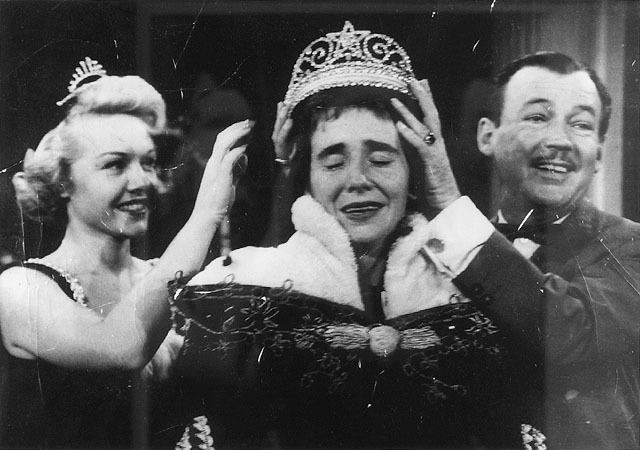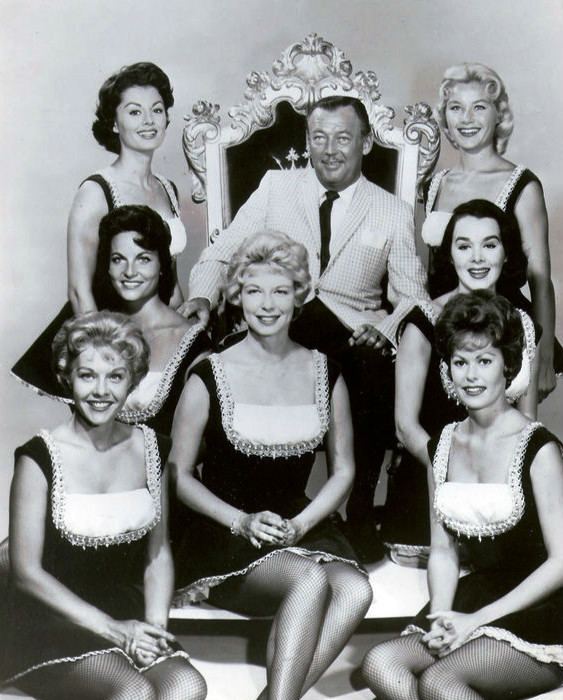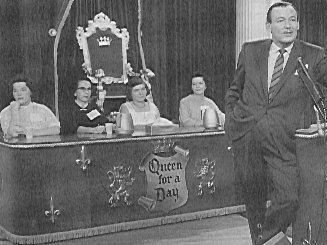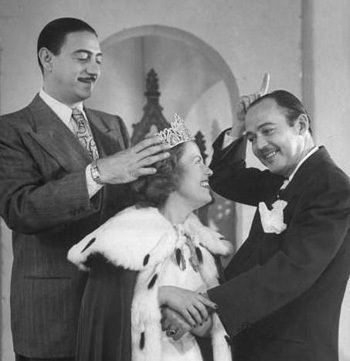6.2 /10 1 Votes6.2
7.1/10 TV Narrated by Gene BakerJohn Harlan Original language(s) English Running time 30 minutes, later 45 Final episode date 27 May 2004 | 5.4/10 IMDb Created by John Masterson Country of origin United States Executive producer(s) John Masterson First episode date 30 April 1945 Program creator John Masterson | |||||||||||||||||||||||||||||||||
 | ||||||||||||||||||||||||||||||||||
Cast Similar Truth or Consequences, Who Do You Trust?, Beat the Clock, Mind Your Language, It Could Be You | ||||||||||||||||||||||||||||||||||
Queen for a Day was an American radio and television game show that helped to usher in American listeners' and viewers' fascination with big-prize giveaway shows. Queen for a Day originated on the Mutual Radio Network on April 30, 1945, in New York City before moving to Los Angeles a few months later and ran until 1957. The show then ran on NBC Television from 1956 to 1960 and on ABC Television from 1960 to 1964.
Contents
- Format
- Radio
- Film
- Television
- Revivals
- Australia
- Brazil
- Spanish
- Ownership rights
- Similar shows
- Episode status
- References

The show became popular enough that NBC increased its running time from 30 to 45 minutes to sell more commercials, at a then premium rate of $4,000 per minute.

Format

The show opened with host Jack Bailey asking the audience—mostly women—"Would YOU like to be Queen for a day?" After this, the contestants were introduced and interviewed, one at a time, with commercials and fashion commentary interspersed in between.

Using the classic applause meter, as did many game and hit parade-style shows of the time, Queen for a Day had its own special twist: Each contestant had to talk publicly about the recent financial and emotional hard times she had been through. The applause meter had also been used on earlier series, including Fred Allen's Judge for Yourself, a variety and game show which aired on NBC from 1953 to 1954.
Bailey began each interview gently, asking the contestant first about her life and family and maintaining a positive and upbeat response no matter what she told him. For instance, when a woman said she had a crippled child, he would ask if her second child was "Okay." On learning that the second child was not crippled, he might say, "Well, that's good, you have one healthy child."
The interview would climax with Bailey asking the contestant what she needed most and why she wanted to win the title of Queen for a Day. Often the request was for medical care or therapeutic equipment to help a chronically ill child, but sometimes it was as simple as the need for a hearing aid, a new washing machine, or a refrigerator. Many women broke down sobbing as they described their plights, and Bailey was always quick to comfort them and offer a clean white handkerchief to dry their eyes.
The harsher the circumstances under which the contestant labored, the likelier the studio audience was to ring the applause meter's highest level. The winner, to the musical accompaniment of "Pomp and Circumstance", would be draped in a sable-trimmed red velvet robe, given a glittering jeweled crown to wear, placed on a velvet-upholstered throne, and handed a dozen long-stemmed roses to hold as she wept, often uncontrollably, while her list of prizes was announced.
The prizes, many of which were donated by sponsoring companies, began with the necessary help the woman had requested but built from there. They might include a variety of extras, such as a vacation trip, a night on the town with her husband, silver-plated flatware, an array of kitchen appliances, or a selection of fashion clothing. The losing contestants were each given smaller prizes; no one went away from the show without a meaningful gift.
Bailey's trademark sign-off was: "This is Jack Bailey, wishing we could make every woman a queen, for every single day!"
Radio
Ken Murray hosted the original radio version of the show on the Mutual–Don Lee Radio Network. When the series began, in New York City on April 30, 1945, it was titled Queen for Today. A few months later, the show moved to Hollywood and acquired the more familiar title Queen for a Day. with Jack Bailey, a former vaudeville musician and World's Fair barker, as host. The show aired five days a week, during the daytime.
Film
In 1951, a fictional comedy-drama film adaptation of the show was released by United Artists. Titled Queen for a Day, it purported to be a behind-the-scenes look at the show while at the same time spoofing the show's basic premise. The movie starred Bailey as the host and featured Darren McGavin, Phyllis Avery, and Leonard Nimoy, among others.
Television
Bailey stayed on as host as Queen for a Day jumped from radio to television. With the addition of a visual component, the fashion aspect of the show expanded and each episode featured three to five young women modelling the upscale apparel that would be given away to contestants. Other visual stunts, such as a circus-themed episode featuring ponies and clowns from Ringling Brothers Barnum and Bailey Circus, helped bring the show into the television era. Through all of these changes, however, Bailey remained the interviewer who, over and over again, brought the contestants—and the live female audience—to tears. The first televised episode, a rebroadcast of an earlier radio episode, featured Pearl Stevens of Claremont, California.
Live remote broadcasts and unscripted interviews added to the show's believability. One of the show's telecast locations was the Earl Carroll Theatre on Sunset Blvd. in Hollywood, renamed the Moulin Rouge in 1953. During each episode, the cameras panned over the audience as the women waved and cheered.
From 1948 through 1955, the show was simulcast on radio and television. Both versions aired locally in the Los Angeles market on the Don Lee network.
NBC picked up the show for national broadcast from January 3, 1956 to September 2, 1960, and aired it live across the nation (1:30 PST in Los Angeles and 4:30 EST in New York). It proved to be very popular and Bailey and the program were featured on the cover of TV Guide for the week of June 22–28, 1957.
ABC broadcast the series nationally from September 5, 1960, until the end of the run on October 2, 1964.
Revivals
On September 8, 1969, after a five-year hiatus, a new version of the show debuted in syndication with Dick Curtis as host. The premise remained largely the same; however, this version only ran until September 18, 1970.
Viewers turned away from the format when it was revealed that, unlike the radio and earlier television versions, the new show was rigged and the "winners" were apparently paid actresses chosen to "win" the prizes prior to the start of each taping.
On May 27, 2004, after being off the air for more than 34 years, it was revived as a one-time special airing on cable network Lifetime with actress and comedian Mo'Nique as host. Judges for this version were Joely Fisher, Meshach Taylor, and Dayna Devon. The only difference between this version and the original was that the winner was not determined by audience applause.
Australia
An Australian version aired in Melbourne on station HSV-7 from 1960 to 1962.
Brazil
The Brazilian version was hosted by Silvio Santos and aired on The Globo in 1972 under the title Boa Noite Cinderella (Good Night, Cinderella). This version awarded gifts for children (mainly little girls) instead of housewives. Years later, when the channel changed from TVS to SBT, it aired the program in the afternoons, dropping "Good Night" in its title and renaming it Cinderella, until it was cancelled in 1987.
Spanish
In the winter of 2011, a Spanish-language revival hosted by Thomas Ramos (better known as The Red Shadow animator) aired on Univision in Puerto Rico under the name Reina Por Un Dia (Queen for a Day).
In Mexico, an Aztec TV version was produced. It was originally hosted by Ingrid Coranado and then by Raquel Bigorra.
Ownership rights
The format is currently owned by television executive Michael Worstman, who shopped the format around for a revival in 2011 without success.
Similar shows
Queen for a Day shared much in common with two other shows of its era, Strike It Rich (on radio and television from 1947 to 1958) and It Could Be You (on television from 1956 to 1961).
A third similar show was On Your Way (on the DuMont Television Network and ABC from 1953 to 1954), which also used contestants with unfortunate stories, giving them transportation tickets as a reward for correct answers to quiz questions.
The major difference between Queen for a Day and these other "sympathy shows" was that they asked their poverty-stricken contestants to win prizes within a conventional quiz show format, with the winner essentially earning the prizes through his or her cleverness. Queen for a Day, on the other hand, dispensed with the quiz-show format entirely: All the contestants were women, and the only way a woman could win was by sincerely touching the heart-strings of the live female audience, who would then award her the greatest volume on the "applause meter."
Episode status
Recordings of the series are believed to have been destroyed, as per network practices of the era.
Eight episodes are held at the UCLA Film and Television Archive, including two from the Don Lee network era: the August 21, 1953, radio episode simulcast on television in Los Angeles and the July 4, 1955, show with Adolphe Menjou guest-hosting to crown a king instead of a queen (as was done about once or twice a year). The latest episode held at the archive is from July 13, 1964, near the end of the show's run on ABC.
Two kinescoped episodes from 1956 exist in the J. Fred & Leslie W. MacDonald Collection of the Library of Congress. These include a 45-minute installment from February 2, 1956, and a half-hour installment from October 25, 1956.
In 2005, First Look Media released a three-disc DVD set of seven episodes transferred from their original kinescope elements plus rare footage of an additional five episodes; the total runtime is 210 minutes.
